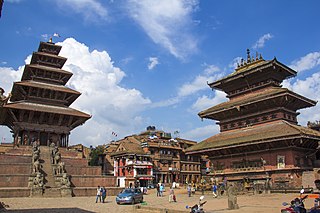
Bhaktapur, known locally as Khwopa and historically called Bhadgaon, is a city in the east corner of the Kathmandu Valley in Nepal located about 13 kilometres (8.1 mi) from the capital city, Kathmandu. Bhaktapur is the smallest city of Nepal as well as the most densely populated. Along with Kathmandu and Lalitpur, Bhaktapur is one of the three main cities of the Kathmandu Valley and is a major Newar settlement of the country. The city is also known for its Newar tradition, cuisine and artisans. Bhaktapur suffered heavy damage in the April 2015 earthquake.
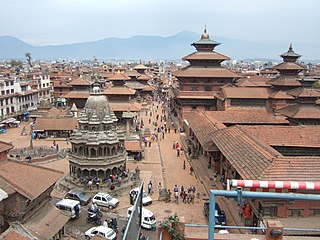
Lalitpur Metropolitan City is a metropolitan city and fourth most populous city of Nepal with 299,843 inhabitants living in 49,044 households per the 2021 census. It is located in the south-central part of Kathmandu Valley, a large valley in the high plateaus in central Nepal, at an altitude of 1,400 metres.

Gosaikunda, also spelled Gosainkunda, is an alpine freshwater oligotrophic lake in Nepal's Langtang National Park, located at an elevation of 4,380 m (14,370 ft) in the Rasuwa District with a surface area of 13.8 ha. Together with associated lakes, the Gosaikunda Lake complex is 1,030 ha in size and was designated a Ramsar site on 29 September 2007.

Muktinath is an ancient Vishnu temple located in Mustang, Nepal. The temple of Muktinath, known as 'the lord of liberation', is sacred to both Hindus and Buddhists whom they worship as an abode of Hindu deity Vishnu and Buddhist deity Avalokiteśvara respectively. Located in the Muktinath valley at the foot of the Thorong La mountain pass, it is one of the world's highest temples at an altitude of 3,800 meters. The temple is given a status of one of the 108 Divya Desams of Hinduism and the only Divya Desam located outside India. It is also one of the 51 Shakti Pitha, associated with the head of goddess Sati. The temple complex is known as Mukti Kshetra, which literally means "the place of liberation (moksha)" and is one of the Char Dham in Nepal.
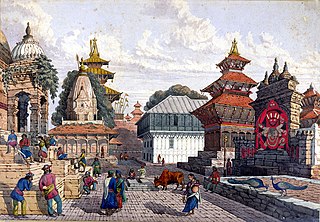
The Malla dynasty also known as the Malla confederacy, was the ruling dynasty of the Kathmandu Valley in Nepal from 1201 to 1779. This dynasty was founded by Arideva Malla. Though the latter Mallas were regarded as belonging to the Raghuvamsha dynasty, they were also seen as continuations and descendants of the Licchavi dynasty. Later Malla kings also traced one section of their lineage from Nanyadeva, the founder of the Karnat dynasty of Mithila. The term malla means wrestler in Sanskrit. The first use of the word malla in the Kathmandu Valley began in 1201.

A dhunge dhara or hiti is a traditional stone drinking fountain found in Nepal. It is an intricately carved stone waterway through which water flows uninterrupted from underground sources. Dhunge dharas are part of a comprehensive drinking water supply system, commissioned by various rulers of Ancient and Medieval Nepal. The system is supported by numerous ponds and canals that form an elaborate network of water bodies, created as a water resource during the dry season and to help alleviate the water pressure caused by the monsoon rains. After the introduction of modern, piped water systems, starting in the late 19th century, this old system has fallen into disrepair and some parts of it are lost forever. Nevertheless, many people of Nepal still rely on the old dhunge dharas on a daily basis.

Badarinath or Badarinarayana Temple is a Hindu temple dedicated to Vishnu. It is situated in the town of Badrinath in Uttarakhand, India. The temple is also one of the 108 Divya Desams dedicated to Vishnu—holy shrines for Vaishnavas—who is worshipped as Badrinath. It is open for six months every year, because of extreme weather conditions in the Himalayan region. The temple is located in Garhwal hill tracks in Chamoli district along the banks of Alaknanda River. It is one of the most visited pilgrimage centers of India, having recorded 2.8 million visits in just 2 months in 2022. It is one of the Char Dham pilgrimage sites.

Kedarnath Temple is a Hindu temple, one of the twelve jyotirlinga of Shiva. The temple is located on the Garhwal Himalayan range near the Mandakini river, in the state of Uttarakhand, India. Due to extreme weather conditions, the temple is open to the general public only between the months of April and November. During the winters, the vigraha (deity) of the temple is carried down to Ukhimath to be worshipped for the next six months. Kedarnath is seen as a homogeneous form of Shiva, the 'Lord of Kedarkhand', the historical name of the region.

Rani Pokhari, originally known as Nhu Pukhu, is a historic artificial pond located in the heart of Kathmandu, Nepal. The square-shaped tank dates from the 17th century, and was built on the eastern side of the then city limits. It lies just outside a former city gate. The pond is one of Kathmandu's most famous landmarks and is known for its religious and aesthetic significance. Its dimensions are 180m by 140m.
Jayayakshya Malla was the son of Jayajyotir Malla and the last Malla king of the united Kathmandu Valley from around 1428 until his death in 1482. The valley was divided among his sons after his death.

The architectural heritage of Kathmandu city is integral to that of the Kathmandu valley since all monuments have evolved over centuries of craftsmanship influenced by Hindu and Buddhist religious practices. The architectural treasure of the Kathmandu valley has been categorized under the well known seven groups of heritage monuments and buildings. In 2006, UNESCO declared these seven groups of monuments as a World Heritage Site (WHS). The seven monuments zones cover an area of 188.95 hectares, with the buffer zone extending to 239.34 hectares. The Seven Monument Zones (Mzs) inscribed originally in 1979 with a minor modification in inscribed year as 2006, are: Five monuments in Kathmandu – Durbar square of Hanuman Dhoka, Hindu temples of Pashupatinath and Changunarayan, the Buddha stupas of Swayambu and Boudhanath; and two monuments outside Kathmandu city limits, in the satellite towns of Patan and Bhktapur – Durbar square at Patan, Durbar square at Bhaktapur. Brief details of the five Kathmandu city monuments are elaborated here.

Bhaktapur Durbar Square is a former royal palace complex located in Bhaktapur, Nepal. It housed the Malla kings of Nepal from 14th to 15th century and the kings of the Kingdom of Bhaktapur from 15th to late 18th century until the kingdom was conquered in 1769. Today, this square is recognised by UNESCO, managed jointly by the Archeological Department of Nepal and Bhaktapur Municipality, and is undergoing extensive restoration due to the damages from the earthquake in 1934 and the recent earthquake of 2015.
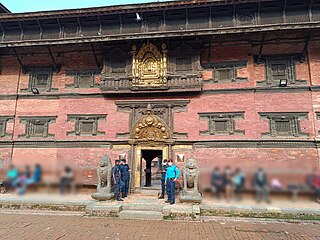
Patan Durbar Square is situated at the centre of the city of Lalitpur in Nepal. It is one of the three Durbar Squares in the Kathmandu Valley, all of which are UNESCO World Heritage Sites. One of its attractions is the medieval royal palace where the Malla Kings of Lalitpur resided.
Rajopadhyaya also called Newari Brahmin is the main division of Newar Brahmins in Nepal. The Rajopadhyayas claim to be originated in Kānyakubja or modern day Kannauj, in the north of India, a city with a prestigious history from where the Bahuns also claim to come. They along with Bahuns claim to be sub-division of Kānyakubja Brāhmins.

Pratap Malla was a Malla king and the eighth King of Kantipur from 1641 until his death in 1674. He attempted to unify Kathmandu Valley by conquering Lalitpur and Bhaktapur, but failed in the effort. He was successful in extending and securing the borders of Kantipur and was responsible for the monopoly over trade with Tibet. The resulting prosperity led to the construction of the majority of the buildings around Durbar Square during his reign. His reign is seen as a cultural and economic high point of the Malla dynasty.
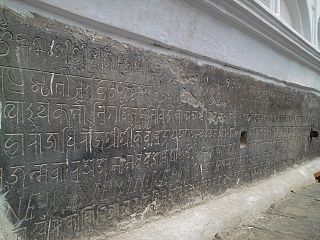
Stone inscriptions in the Kathmandu Valley refer to ancient stone slabs, pillars and pedestals with text carved on them. They are the most important sources for the history of Nepal. A vast majority of the inscriptions found in Nepal are from the Kathmandu Valley where they are an ubiquitous element at heritage sites. They consist of royal edicts and dedicatory notes on Hindu and Buddhist temples, stupas, statues, water spouts and other architectural structures. Stone inscriptions are locally referred as Lōhan Pau.

Kumbheshwar Temple is one of the oldest Hindu temples, situated 200m from the northern part of Patan Durbar Square. It was built in the 14th century by King Jayasthiti Malla which makes it the oldest temple in Patan. It is one of the two free-standing, five-story temples, the other being the famous Nyatapola temple of Bhaktapur. The temple is noted for its graceful proportions and fine woodcarvings and is dedicated to Shiva, as indicated by the large Nandi, or bull, facing the temple.

Jal Binayak is a Hindu Temple of Lord Ganesh located in the Chobhar, central part of Kathmandu District, Nepal. The Jal Binayak temple is the most important Ganesh shrine of the central region Kathmandu. It is one of the four Binayak of Kathmandu Valley.
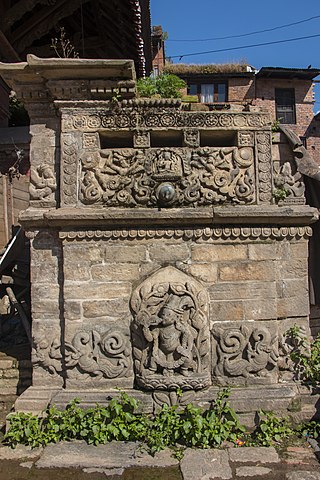
A tutedhara (Nepali) or jahru (Newari) is a traditional drinking fountain found in Nepal. It is a water reservoir built out of stone with a tap that can be opened and closed. These structures are either free-standing or integrated into the wall of another building. They depend on a water well or a dhunge dhara to be filled. Only a few of them are in use today, but some of the stone parts have been put to other uses, and there are contemporary equivalents. The best known tutedhara is the one built into a wall in the royal palace on Kathmandu Durbar Square. It is inscribed with a poem dedicated to the goddess Kali, written in fifteen different languages.

Alko Hiti, also known as Alkwo Hiti, Aluko Hiti or Alok Hiti is a 15th-century dhunge dhara in the city of Patan, Nepal. Thanks to the active involvement of the people who rely on this dhunge dhara for their drinking water, Alko Hiti has remained operational from the time it was built to the present day.





















